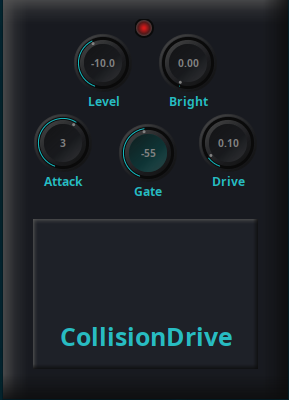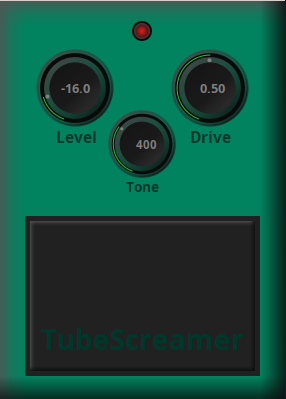ToneTwist Plugs
MetalTone

MetalTone is modeled after the renowned BOSS MT-2 Metal Zone(*), a high gain distortion pedal with an advanced EQ section.
It has standard active EQ controls with a massive 15dB of cut/boost range for the lows and highs. It also sports a parametric active EQ for the mids with two controls: the frequency, and the boost/cut amount.
The midfreq parameter has a very wide range, going from 200Hz all the way to 5kHz. As a result, it's better to think of it simply as a single highly flexible active EQ, and disregard the idea that it's only for shaping the mids.
Features: Modeled by Brummer Based on the BOSS MT-2 Metal Zone(*)
(*) 'Other product names modeled in this software are trademarks of their respective companies that do not endorse and are not associated or affiliated with this software. BOSS MT-2 Metal Zone is a trademark or trade name of another manufacturer and was used merely to identify the product whose sound was reviewed in the creation of this product. All other trademarks are the property of their respective holders.
CollisionDrive

CollisionDrive is modeled after the Horizon Devices Precision Drive(*), a modern overdrive pedal with a built-in noise gate.
Besides the usual Volume and Drive controls, the CollisionDrive features Attack and Bright controls.
The Attack control manipulates the response of the pedal, turning it down simultaneously softens the overdrive attack and increases the sustain.
The Bright control gives you even more flexibility. It can add presence to darker sounding amps, or remove buzzing when needed.
The Gate control sets the noise gate threshold. In the plugin interface, this control lights up to indicate that the noise gate is active.
Features: Modeled by Brummer Based on the Horizon Devices Precision Drive(*)
(*) 'Other product names modeled in this software are trademarks of their respective companies that do not endorse and are not associated or affiliated with MOD. Horizon Devices Precision Drive is a trademark or trade name of another manufacturer and was used merely to identify the product whose sound was reviewed in the creation of this product. All other trademarks are the property of their respective holders.
Rumor

The Rumor is modeled after the Devi Ever Ruiner(*), a pure, nasty growling Bass Fuzz pedal, with bold out-front presence, and cutting articulation.
It features Level and a Intensity control.
Features: Modeled by Brummer Based on the Devi Ever Ruiner(*)
(*) 'Other product names modeled in this software are trademarks of their respective companies that do not endorse and are not associated or affiliated with this software. Devi Ever Ruiner is a trademark or trade name of another manufacturer and was used merely to identify the product whose sound was reviewed in the creation of this product. All other trademarks are the property of their respective holders.'
TubeScreamer

TubeScreamer is a analog emulation of the classic Ibanez TS-9(*)
Features: Modeled by Brummer Based on the Ibanez TS-9(*)
(*) 'Other product names modeled in this software are trademarks of their respective companies that do not endorse and are not associated or affiliated with this software. Ibanez TS-9 is trademark or trade name of other manufacturer and was used merely to identify the product whose sound was reviewed in the creation of this product. All other trademarks are the property of their respective holders.'
ValveCaster

The ValveCaster is a famous DIY guitar pedal schematic first put together in 2007 by Matsumin. Originally, the goal was to create a real tube boost/overdrive pedal that would run on a single 9 volt battery. With its wide range of drives, distortions and fuzzes, the ValveCaster adds a harsher, brighter colouring to the sound while offering a precise, nuanced range within the tone control.
Features: Modeled by Brummer Based on the ValveCaster by Matsumin
BoobTube

The BoobTube is a more versatile variation of the ValveCaster, a famous DIY guitar pedal schematic first put together in 2007 by Matsumin.
The BoobTube offers a warm, harmonically rich range of tones, from bright fuzzes to darker distortions, without actually colouring the sound. The DIY project quickly became popular amongst sound enthusiasts searching for that tube-y goodness.
Features: Modeled by Brummer Based on the BoobTube by Matsumin
Formats
ToneTwist Plugs come in the following plug-in formats:
Compiling
Make sure you have installed the required build tools and libraries (see
section "Prerequisites" below) and then clone this repository (including
sub-modules) and simply run make in the project's root directory:
git clone --recursive https://github.com:brummer10/ToneTwistPlugs
cd ToneTwistPlugs
makeInstallation
To install all plugin formats to their appropriate system-wide location, run the following command (root priviledges may be required):
make installThe makefiles support the usual PREFIX and DESTDIR variables to change the
installation prefix and set an installation root directory (defaulty: empty).
PREFIX defaults to /usr/local, but on macOS and Windows it is not used,
since the system-wide installation directories for plugins are fixed.
Use make's -n option to see where the plugins would be installed without
actually installing them.
You can also set the installation directory for each plugin format with a dedicated makefile variable.
- LV2:
LV2_DIR(<prefix>/lib/lv2) - VST2:
VST3_DIR(<prefix>/lib/vst2) - VST3:
VST3_DIR(<prefix>/lib/vst3) - CLAP:
CLAP_DIR(<prefix>/lib/clap)
Example:
make DESTDIR=/tmp/build-root PREFIX=/usr VST2_DIR=/usr/lib/lxvst installTo install the plugins only for your current user account, run:
make install-userAgain, you can also set the installation directory for each plugin format with a dedicated makefile variable.
- LV2:
USER_LV2_DIR($HOME/.lv2) - VST2:
USER_VST2_DIR($HOME/.vst2) - VST3:
USER_VST3_DIR($HOME/.vst3) - CLAP:
USER_CLAP_DIR($HOME/.clap)
Note: The given default values for all of the above listed environment variables differ depending on the target OS.
Prerequisites
-
The GCC C++ compiler, library and the usual associated software build tools (GNU
make, etc.).Debian / Ubuntu users should install the
build-essentialpackage to get these, Arch users thebase-develpackage group.
The LV2, VST2 (Xaymar/vst2sdk) and VST3 (travesty) headers are included in the DPF framework, which is integrated as a Git sub-module. These need not be installed separately to build the software in the respective plug-in formats.
Author
This software was created by brummer.
Acknowledgements
This project is built using the DISTRHO Plugin Framework (DPF)